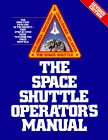|
Astronomy Portal to the Heavens, Deep Sky and Universe
|
|
Space Shuttle Operations Guide Information in this guide is extracted from the NSTS 1988 News Reference Manual, the Spacecraft Operators Reference Manual (not available to the
general public) and my own knowledge from working at Kennedy Space Center. The purpose of this guide is to condense the extensive Space Shuttle flight operations into an easy to read format. Space Shuttle Assembly The Space Shuttle assembly consist of three major elements, the Orbiter, External Tank (ET) and the Solid Rocket Boosters (SRBs). While the Orbiter is the space vehicle that the crew lives and works aboard the other two components are responsible for getting them into Low Earth Orbit ( LEO ). Upon launch the SRBs burn with the aim to lift the space vehicle out of astomsphereic drag and on the correct mission trajectory. After providing the needed vertical velocity the solids will then separate from the Shuttle and fall back to Earth. It is now up to the three Space Shuttle main engines (SSME) to provide the horizontal velocity necessary to bring the vehicle close to the LEO velocity. The main engines are supplied with fuel (liquid hydrogen) and oxidizer (liquid oxygen) by the ET until the Orbiter is nearly but not quite into orbit. After main engine cut off (MECO) the ET will fall away and return to Earth and the remaining liquid oxygen in the Orbiter is dumped through the nozzles of the three SSMEs. The remaining liquid hydrogen is dumped overboard through the hydrogen fill and drain valves. Then the two orbital maneuvering system (OMS) engines will burn long enough to bring the vehicle into a stable orbit.. If the Orbiter is to go into a higher orbit a second burn will take place, referred to as OMS-2. This occurs near the apogee of the orbit established by the OMS-1 thrusting period and is used to circularize the predetermined orbit for that mission. The fuel for the OMS is Monomethylhydrazine and the oxidizer is Nitrogen Tetroxide. The reaction control system (RCS) units provide the thrust for attitude (rotational) maneuvers (pitch, yaw and roll) and for small velocity changes along the orbiter axis (translation maneuvers) while the vehicle is in orbit. Each RCS consists of high-pressure gaseous helium storage tanks, pressure regulation and relief systems, a fuel and oxidizer tank, a system that distributes propellant to its engines, and thermal control systems (electrical heaters). Orbiter Main Engines The SSMEs are gimbaled into position by servoacutators under hydraulic pressure provided by the hydraulic system. The auxiliary power units ( APU) power the gear train to drive the hydraulic pumps that provide hydraulic pressure to their respective hydraulic systems. The APUs are fueled by hydrazine. Orbiter Compartments The main internal compartment of the orbiter are the flight deck (forward/aft ), the middeck and the airlock module. The flight deck houses the Orbiter crew station displays and flight controls. The middeck is the crews living quarters and supply storage area. If need be bunk sleep stations and a galley can be installed in the middeck. The Orbiter airlock module provides access to the payload bay and houses the EMUs for space walks. While on the ground entry into the Orbiter is to the middeck crew compartment. The compartment has a side hatch for normal ingress and egress, a hatch into the airlock from the middeck, and a hatch from the airlock through the aft bulkhead into the payload bay for extravehicular activity and payload bay access. It should be noted that the airlock ceiling is common with the middeck floor. Thus, when the vehicle is in the horizontal position on the ground the panels in this airlock appear upside down. There are two interdeck openings in the middeck ceiling to access the aft flight deck crew station. The aft flight deck crew station has two overhead and aft viewing windows for viewing orbital operations. The aft flight deck station also contains displays and controls for executing attitude or translational maneuvers for rendezvous, stationkeeping, docking, payload deployment and retrieval, payload monitoring, remote manipulator system controls and displays, payload bay door operations and closed-circuit television operations. Orbiter Avionics The flight deck is the center of avionics activity, both in flight and on the ground. The forward flight deck is where the pilot and commanders seats are located . The left side facing forward (vehicle port side) is the Commander's (CDR's) station and the right side (vehicle starboard side) is the Pilot's (PLT's) station. The center portion is common to both stations. There are three stations located in the aft Flight Deck. The aft facing panels are the Orbit Station. The aft right (starboard) side is the Mission Station. The aft left (port) side is the Payload Station. The vehicle's status and operational readiness is determined through the Space Shuttle avionics system controls. This system handles communications, guidance, navigation and control. Before launch, the orbiter avionics system is linked to ground support equipment through umbilical connections. The space shuttle avionics system are connected to a set of five general-purpose computers (GPC) through common party lines called data buses. The system software is the GPC operating software that controls the interfaces among the computers and the rest of the data processing system. The GPCs interact with the processing system from countdown T minus 20 minutes (when they are loaded with OPS 1 software and formed into the four GPCs referred to as the primary avionics software system) until lift-off. Prior to this prelaunch functions are controlled by a ground computer network at the launch site in the primary firing room.
|
Space Exploration DVDs
| Space Exploration Books | From the Earth to the Moon | Earthlight: NASA - Spectacular Views
|
